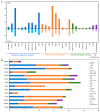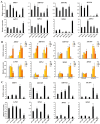Genome-Wide Analysis of BURP Domain-Containing Gene Family in Solanum lycopersicum and Functional Analysis of SlRD1 Under Drought and Salt Stresses
- PMID: 39684251
- PMCID: PMC11641390
- DOI: 10.3390/ijms252312539
Genome-Wide Analysis of BURP Domain-Containing Gene Family in Solanum lycopersicum and Functional Analysis of SlRD1 Under Drought and Salt Stresses
Abstract
The BURP domain-containing (BURP) genes belong to plant-specific families and are known as essential for various biological processes in plants. However, knowledge of the functions of BURP genes in tomato (Solanum lycopersicum) is lacking. In our study, bioinformatics analysis was performed for the SlBURP gene family, including phylogeny, chromosomal localization, gene structure, cis-acting elements and expression. In addition, the function of SlRD1 in drought and salt stresses was explored. In tomato, fourteen BURP family members were identified, located on five chromosomes, including two tandem duplication clusters. These BURP members were classified into four subfamilies. The promoter regions of SlBURPs harbored numerous hormone- and stress-response elements. Tissue expression analysis showed that several SlBURPs were highly expressed in roots, flowers or fruits. Meanwhile, the expressions of most SlBURPs could be regulated by drought, salt and cold treatments, and some of them also responded to ABA treatment. Moreover, the ectopic expression of SlRD1 in Arabidopsis enhanced tolerances to drought and salt stresses and increased the sensitivity of seed germination to ABA. In conclusion, the comprehensive analysis of the SlBURP family in tomato and the functional exploration of SlRD1 in drought and salt stresses provide a basis for further dissecting the roles of tomato BURP genes.
Keywords: BURP domain-containing genes; SlRD1; drought; salt; tomato.
Conflict of interest statement
The authors declare no conflicts of interest.
Figures









Similar articles
-
Whirly (Why) transcription factors in tomato (Solanum lycopersicum L.): genome-wide identification and transcriptional profiling under drought and salt stresses.Mol Biol Rep. 2019 Aug;46(4):4139-4150. doi: 10.1007/s11033-019-04863-y. Epub 2019 May 14. Mol Biol Rep. 2019. PMID: 31089915
-
Genome-Wide Identification and Expression Analysis of the High-Mobility Group B (HMGB) Gene Family in Plant Response to Abiotic Stress in Tomato.Int J Mol Sci. 2024 May 28;25(11):5850. doi: 10.3390/ijms25115850. Int J Mol Sci. 2024. PMID: 38892039 Free PMC article.
-
Genome-Wide Identification and Expression Analysis of Tomato ADK Gene Family during Development and Stress.Int J Mol Sci. 2021 Jul 19;22(14):7708. doi: 10.3390/ijms22147708. Int J Mol Sci. 2021. PMID: 34299327 Free PMC article.
-
Genome-wide identification and characterization of the thioredoxin (TRX) gene family in tomato (Solanum lycopersicum) and a functional analysis of SlTRX2 under salt stress.Plant Physiol Biochem. 2025 Mar;220:109478. doi: 10.1016/j.plaphy.2025.109478. Epub 2025 Jan 7. Plant Physiol Biochem. 2025. PMID: 39826344
-
Genome-wide identification of BURP domain-containing genes in rice reveals a gene family with diverse structures and responses to abiotic stresses.Planta. 2009 Jun;230(1):149-63. doi: 10.1007/s00425-009-0929-z. Epub 2009 Apr 12. Planta. 2009. PMID: 19363683
Cited by
-
Long-Term Phytaspase Responses in Nicotiana benthamiana: Sustained Activation by Mechanical Wounding, but Not by Drought, Heat, Cold, or Salinity Stress.Int J Mol Sci. 2025 Jul 24;26(15):7170. doi: 10.3390/ijms26157170. Int J Mol Sci. 2025. PMID: 40806303 Free PMC article.
-
Anticancer Ribosomally Synthesized and Post-Translationally Modified Peptides from Plants: Structures, Therapeutic Potential, and Future Directions.Curr Issues Mol Biol. 2024 Dec 26;47(1):6. doi: 10.3390/cimb47010006. Curr Issues Mol Biol. 2024. PMID: 39852121 Free PMC article. Review.
-
Exploring the Roles of the Plant AT-Rich Sequence and Zinc-Binding (PLATZ) Gene Family in Tomato (Solanum lycopersicum L.) Under Abiotic Stresses.Int J Mol Sci. 2025 Feb 16;26(4):1682. doi: 10.3390/ijms26041682. Int J Mol Sci. 2025. PMID: 40004146 Free PMC article.
References
-
- Albacete A., Ghanem M.E., Martínez-Andújar C., Acosta M., Sánchez-Bravo J., Martínez V., Lutts S., Dodd I.C., Pérez-Alfocea F. Hormonal changes in relation to biomass partitioning and shoot growth impairment in salinized tomato (Solanum lycopersicum L.) plants. J Exp. Bot. 2008;59:4119–4131. doi: 10.1093/jxb/ern251. - DOI - PMC - PubMed
-
- Liu H., Ma Y., Chen N., Guo S., Liu H., Guo X., Chong K., Xu Y. Overexpression of stress-inducible OsBURP16, the β subunit of polygalacturonase 1, decreases pectin content and cell adhesion and increases abiotic stress sensitivity in rice. Plant Cell Environ. 2014;37:1144–1158. doi: 10.1111/pce.12223. - DOI - PMC - PubMed
-
- Harshavardhan V.T., Van Son L., Seiler C., Junker A., Weigelt-Fischer K., Klukas C., Altmann T., Sreenivasulu N., Bäumlein H., Kuhlmann M. AtRD22 and AtUSPL1, members of the plant-specific BURP domain family involved in Arabidopsis thaliana drought tolerance. PLoS ONE. 2014;9:e110065. doi: 10.1371/journal.pone.0110065. - DOI - PMC - PubMed
MeSH terms
Substances
Grants and funding
LinkOut - more resources
Full Text Sources

